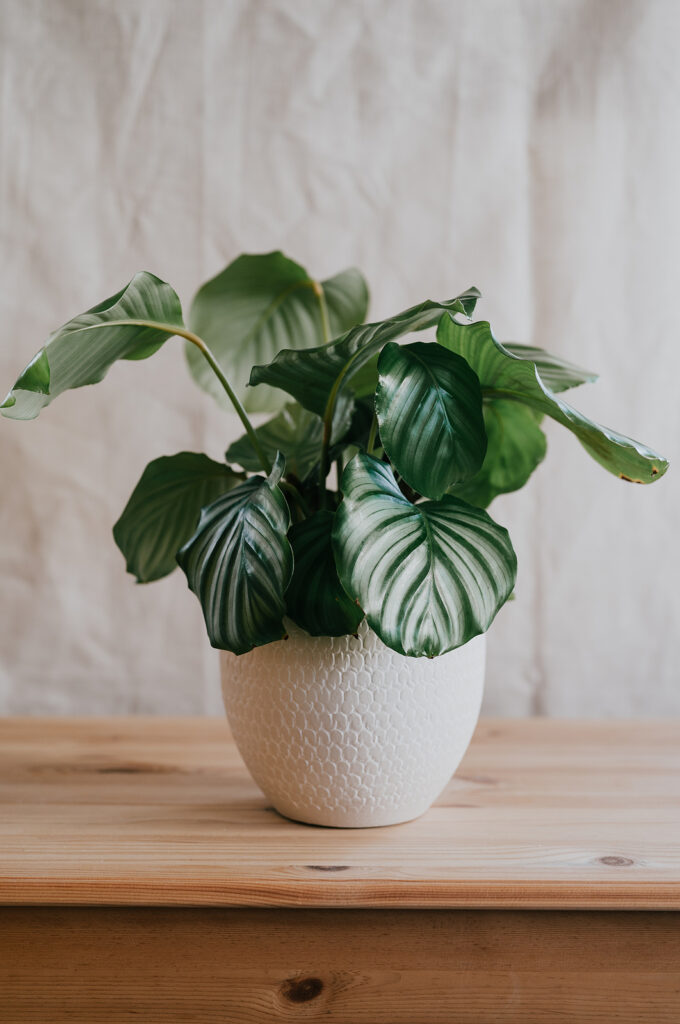Calatheas are upright, leafy houseplants grown for their ornately patterned leaves. Their spectacular foliage bears colored veins or prominent blotches on backgrounds that range from white to almost black.
Calathea leaves commonly have variegated markings that can take the form of bands, streaks, patches, spots, or stripes. Slender leafstalks form clumps from the center of the plant.
Calatheas require protection from direct sun and love high humidity. Sudden fluctuation in temperature can harm delicate varieties. Low light is recommended; colors fade in bright light.
Calathea is closely related to Maranta and is often confused with it.
Calathea is a genus of about 300 species native to forest margins in Central and South America.
Get to know Calathea
- Plant type: Tropical evergreen, houseplant
- Growing Zones and range: Zones 10-11
- Hardiness: Grow in a warm room, 70° to 75°F (21°-24°C)
- Height and width: Most forms are upright 8 to 18 inches(20-45cm)
- Foliage: Leaves show intricate markings—bands, streaks, patches, spots, or stripes– in shades of green, white, pink, purple, and maroon. Undersides of some types are solid purplish red, contrasting with the patterned surfaces. Slender leafstalks form clumps in the center of the plant.
- Uses: Houseplant, tropical garden
- Common name: Peacock plant, rattlesnake plant, Zebra plant
- Botanical name: Calathea
- Family: Marantaceae
- Origin: Tropical America

Where to plant Calathea
- Calathea needs plenty of filtered light to encourage the richest leaf color; light too abundant or intense will damage leaves.
- Calathea requires high humidity; mist frequently and place the pot on a humidity tray.
- Grow calathea in standard indoor potting soil.
How to water and feed Calathea
- Keep moist at all times—reduce watering in winter. Keep the potting soil constantly moist (like a squeezed-out sponge), but not soggy.
- Fertilize with a liquid fertilizer diluted to half-strength, except in winter.
Calathea care
- Repot in spring every two years. Divide plants at repotting.
- For health and good looks, leaves should be cleaned regularly with a damp cloth; don’t use commercial leaf shine products.
- Calathea is occasionally bothered by aphids, mealybugs, red spider mites, and thrips.
Growing Calathea as a houseplant
- Calateha grows best in bright light; exposure to direct sunlight for long periods can bleach the leaves.
- Calathea needs average to warm room temperature and high humidity.
- The soil should be medium moist, neither dry nor oggy.
- Fertilizer can be applied regularly during spring and summer.
Calathea propagation
- Calathea can be propagated by division.
Calathea varieties to grow
- Calathea insignis, commonly know as rattlesnake plant, has 12 to 18-inch long yellowish-green leaves striped with olive green.
- Calathea makoyana, commonly known as peacock plant, has 10 to 12-inch long oval leaves. Leaf colors include olive green, cream, and pink displayed in interesting patterns.
- Calathea ornata is a sturdy plant whose 8-inch-long leaves are rich green with undersides of purplish red. Pink stripes run between the veins of young leaves.
- Calathea picturata has leafstalks 3 to 4 inches tall and leaves 6 inches long; leaves are deep olive green and have silvery lines along the midrib and margins.
- Calathea roseopicta grows to 8 inches tall with short leaf stalks that bear dark green leaes; leaes have red margin and red midribs that change to silvery pink as leaves mature.
- Calathea xebrina, commonly known as zebra plant, is a more compact type. Leaves grow to about 15 inches bars of pale chartreuse alternate with olive green, undersides are purplish red.















